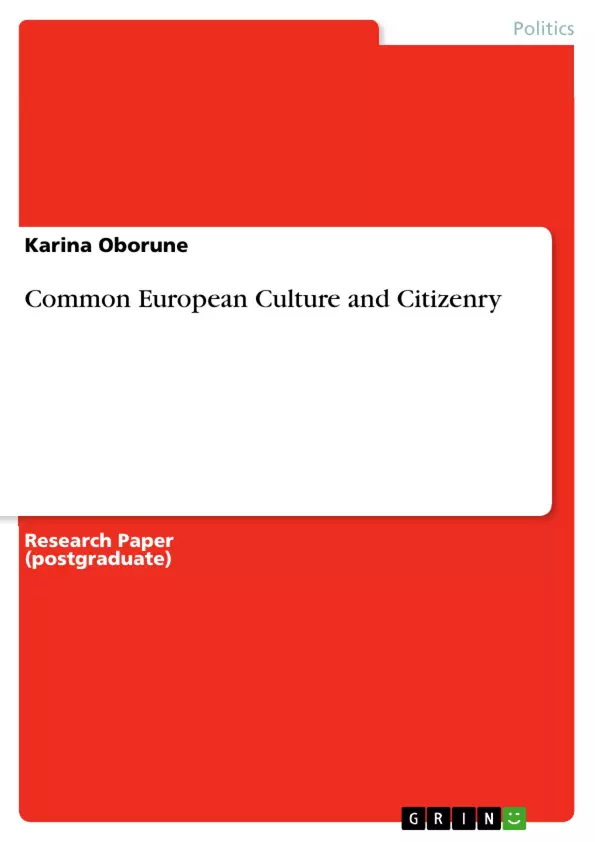
Common European Culture and Citizenry
Forschungsarbeit, 2007
14 Seiten, Note: A+
Leseprobe
Table of Contents
- Definition of the Concept of Common European Culture
- European cultural space is open and dynamic
- There are no clear boundaries of European culture
- The programme 'Culture 2000'
- European culture does not replace national cultures
- Finally, European culture has its roots
- Common European Culture: The Arguments Against and Pro
Objectives and Key Themes
This text aims to explore the concept of a common European culture, examining its definition, characteristics, and challenges. It investigates whether a shared cultural identity exists within the European Union, considering historical roots and contemporary debates. The analysis balances arguments for and against the existence of a unified European culture.
- Definition and scope of European culture
- The dynamic and open nature of European cultural space
- The relationship between European and national cultures
- Historical roots of European cultural values
- Arguments for and against a common European culture
Chapter Summaries
Definition of the Concept of Common European Culture: This chapter grapples with the multifaceted definition of "European culture," acknowledging the lack of a universally agreed-upon definition. It contrasts narrow interpretations focusing on arts and literature with broader ones encompassing values, customs, and institutions. The author argues for the existence of a common European culture, grounded in the vision of the European Union, emphasizing its function in fostering a sense of community and belonging within the wider political project of EU construction. The chapter introduces the concept of culture as both a narrow and wide concept, setting the stage for a nuanced exploration of its implications for European identity.
European cultural space is open and dynamic: This section explores the open and dynamic nature of European cultural space. The "openness" is discussed in two ways: the possibility of enlargement, where new member states contribute fresh elements to the cultural landscape, and the inherent openness to innovation and new ideas while retaining a sense of origin and identity. This dynamism is highlighted as a key characteristic, contrasting with the notion of a static or fixed cultural identity. The chapter uses the inclusion of Eastern Europe after the 1990s as a prime example of this dynamic quality, emphasizing the ever-evolving nature of European cultural identity.
There are no clear boundaries of European culture: This chapter delves into the challenges of defining Europe's geographical and cultural boundaries. It identifies several historical fault lines, including the Roman Empire's reach, the Catholic-Orthodox divide, the Ottoman Empire's influence, industrialization patterns, and the Iron Curtain, acknowledging the complexities in identifying a unified cultural sphere. The discussion highlights the significant cultural variations across Europe despite common historical experiences, suggesting the existence of both similarities and differences, making a comprehensive definition challenging.
The programme 'Culture 2000': This section analyzes the EU's "Culture 2000" program and its objective of creating a "common cultural area characterized by its cultural diversity and shared cultural heritage," reflecting the motto "Unity in diversity." It examines the inherent tension between fostering a singular European identity and promoting cultural pluralism. The chapter discusses the interpretation of "unity in diversity" as a potentially ideological construct, where diversity is encouraged only insofar as it doesn't hinder the pursuit of unity and integration within the EU framework.
European culture does not replace national cultures: This chapter emphasizes that a common European culture does not negate or compete with national cultures. It underscores the EU's commitment to preserving national identities, exemplified by the Treaty of Maastricht. The author argues that a shared European identity can coexist with individual national identities, allowing individuals to feel both European and national at the same time. This point highlights the EU's political strategy of integrating a common European identity without erasing national cultures.
Finally, European culture has its roots: This section explores the historical roots of European culture, tracing its key characteristics through several periods: Ancient Greece (human dignity, critical thinking), Roman civilization (legality), Christianity (community, belonging), and the Renaissance (rationality, humanity). It connects these historical influences with contemporary values such as liberal humanism, civil rights, and participatory democracy, emphasizing the deep historical foundations of the shared European identity.
Common European Culture: The Arguments Against and Pro: This concluding chapter presents arguments both for and against the concept of a common European culture. Arguments against include the internal contradictions within European history (e.g., religious conflicts, instances of tyranny), the non-exclusivity of European values (e.g., democracy's presence in other civilizations), and the potential for political manipulation in defining European identity. The chapter also addresses critiques that common European culture might lead to exclusion, racism, and xenophobia.
Keywords
European culture, European identity, cultural diversity, national cultures, European Union, unity in diversity, historical roots, values, integration, exclusion, racism, xenophobia, cultural policy.
Frequently Asked Questions: A Common European Culture
What is the main topic of this text?
This text explores the concept of a common European culture, examining its definition, characteristics, challenges, and historical roots. It investigates whether a shared cultural identity exists within the European Union, considering arguments both for and against its existence, and the relationship between European and national identities.
What are the key themes explored in the text?
Key themes include the definition and scope of European culture; the dynamic and open nature of European cultural space; the relationship between European and national cultures; the historical roots of European cultural values; and arguments for and against a common European culture. The text also examines the EU's "Culture 2000" program and its implications.
How does the text define "European culture"?
The text acknowledges the lack of a universally agreed-upon definition of "European culture," contrasting narrow interpretations (focused on arts and literature) with broader ones (encompassing values, customs, and institutions). It argues for a common European culture grounded in the vision of the European Union, emphasizing its role in fostering community and belonging.
Is European culture static or dynamic?
The text emphasizes the dynamic and open nature of European culture. "Openness" is discussed in terms of enlargement (new member states contributing new elements) and openness to innovation. The dynamism is highlighted as a key characteristic, contrasting with the notion of a static or fixed cultural identity.
What are the challenges in defining the boundaries of European culture?
The text highlights the difficulty in defining Europe's geographical and cultural boundaries, citing historical factors such as the Roman Empire, the Catholic-Orthodox divide, the Ottoman Empire's influence, industrialization patterns, and the Iron Curtain. It acknowledges significant cultural variations across Europe despite common historical experiences.
What is the role of the "Culture 2000" program?
The text analyzes the EU's "Culture 2000" program, aimed at creating a "common cultural area characterized by its cultural diversity and shared cultural heritage." It examines the tension between fostering a singular European identity and promoting cultural pluralism, and discusses the interpretation of "unity in diversity."
Does a common European culture replace national cultures?
The text explicitly states that a common European culture does not replace national cultures. It emphasizes the EU's commitment to preserving national identities and argues that a shared European identity can coexist with individual national identities.
What are the historical roots of European culture?
The text traces the historical roots of European culture through Ancient Greece (human dignity, critical thinking), Roman civilization (legality), Christianity (community, belonging), and the Renaissance (rationality, humanity). It connects these historical influences with contemporary values such as liberal humanism, civil rights, and participatory democracy.
What are the arguments for and against a common European culture?
Arguments for emphasize the shared values and historical experiences that bind European nations. Arguments against highlight internal contradictions in European history, the non-exclusivity of European values, and the potential for political manipulation in defining European identity. Concerns about exclusion, racism, and xenophobia are also addressed.
What are the key takeaways from this text?
The text offers a nuanced perspective on the concept of a common European culture, acknowledging both its complexities and its potential. It emphasizes the dynamic and evolving nature of European identity, the importance of balancing unity and diversity, and the need to address potential pitfalls in defining and promoting a shared cultural identity.
Details
- Titel
- Common European Culture and Citizenry
- Hochschule
- Latvijas Universitate
- Veranstaltung
- European Union
- Note
- A+
- Autor
- Karina Oborune (Autor:in)
- Erscheinungsjahr
- 2007
- Seiten
- 14
- Katalognummer
- V169132
- ISBN (eBook)
- 9783640872534
- ISBN (Buch)
- 9783640872749
- Dateigröße
- 626 KB
- Sprache
- Englisch
- Schlagworte
- European Union Culture Citizenry Unity in diversity
- Produktsicherheit
- GRIN Publishing GmbH
- Preis (Ebook)
- US$ 15,99
- Preis (Book)
- US$ 17,99
- Arbeit zitieren
- Karina Oborune (Autor:in), 2007, Common European Culture and Citizenry, München, Page::Imprint:: GRINVerlagOHG, https://www.diplomarbeiten24.de/document/169132
- Autor werden
- Ihre Optionen
- Vertriebskanäle
- Premium Services
- Autorenprofil
- Textarten und Formate
- Services für Verlage, Hochschulen, Unternehmen

- © GRIN Publishing GmbH.
- Alle Inhalte urheberrechtlich geschützt. Kopieren und verbreiten untersagt.
- info@grin.com
- AGB
- Open Publishing
Der GRIN Verlag hat sich seit 1998 auf die Veröffentlichung akademischer eBooks und Bücher spezialisiert. Der GRIN Verlag steht damit als erstes Unternehmen für User Generated Quality Content. Die Verlagsseiten GRIN.com, Hausarbeiten.de und Diplomarbeiten24 bieten für Hochschullehrer, Absolventen und Studenten die ideale Plattform, wissenschaftliche Texte wie Hausarbeiten, Referate, Bachelorarbeiten, Masterarbeiten, Diplomarbeiten, Dissertationen und wissenschaftliche Aufsätze einem breiten Publikum zu präsentieren.
Kostenfreie Veröffentlichung: Hausarbeit, Bachelorarbeit, Diplomarbeit, Dissertation, Masterarbeit, Interpretation oder Referat jetzt veröffentlichen!
- GRIN Verlag GmbH
-
- Nymphenburger Str. 86
- 80636
- Munich, Deutschland
- +49 89-550559-0
- +49 89-550559-10
- info@grin.com
-










Kommentare